Far More Than Just Sand
Dunes play an important role in coastal protection worldwide. Scientists from the Institute of Coastal Research at the Helmholtz-Zentrum Geesthacht (HZG) therefore wish to better understand how they grow and change over the course of time. The experts look into the distant past to determine how climate change could influence the dune landscapes in the future. After all, some coastal dune landscapes are already many thousands of years old.
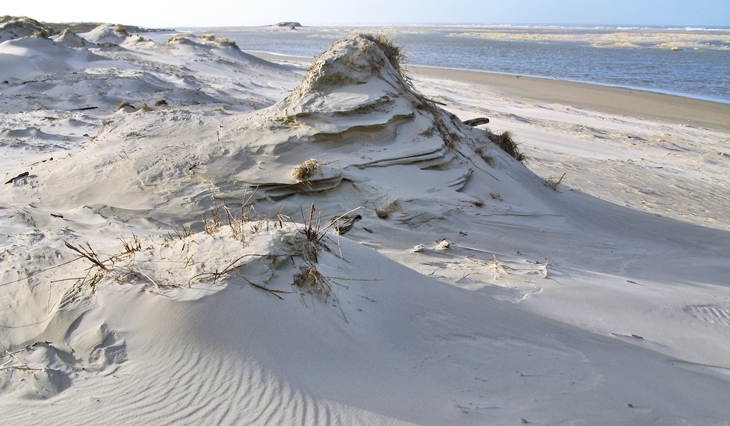
Primary dunes after a storm surge (Photo: Ina Frings)
Many people likely know that by nature dunes are unfixed. There’s a reason for the term „wandering dune“. Dunes can indeed change their form and position over the course of time. They can grow in size if the sea brings sand their way. In other areas, storm surges can rip large holes in the protective vegetation layer, exposing the dune’s sand. Wind and waves then have an easy target and carry the sand away. Nevertheless, they are not as transitory as they seem. Dunes along many coasts around the world have even existed for several thousands of years – including on the Polish Baltic Sea coast. The dunes in some areas there are approximately six thousand years old.
This means that the dunes can serve as something of silent witnesses - witnesses who can reveal a great deal about the coastal past as well as the prevailing weather and climate during earlier periods. Scientists today therefore attempt to ascertain from their form how the wind blew at one time and from which direction the waves had crashed against the dunes. One such scientist exploring the history of the dunes is mathematician Dr Wenyan Zhang from the HZG’s Institute of Coastal Research. Zhang has been taking a close look at the forming and fading of dunes on the German-Polish Baltic Sea coast. “The glimpse into the past is vital for us in understanding how the dunes react to wind and water currents at different locations,” the researcher says, “and not least we want to determine how the dunes could develop due to climate change, the rising sea level and possible changes in wind and water currents.” Zhang’s work is therefore also relevant for coastal protection.
Old data for a sharp eye into the future
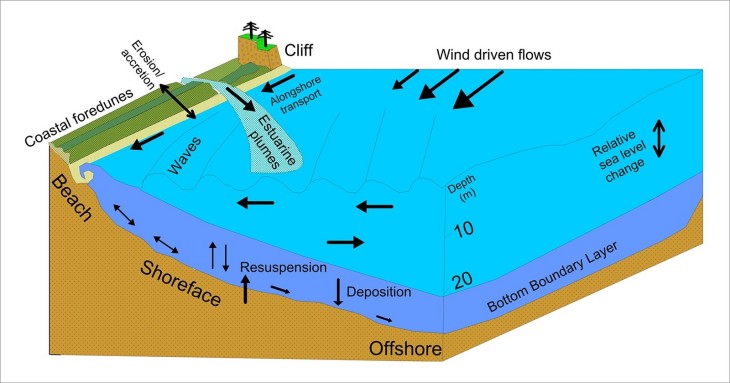
Influencing factors in the changing coastline (Graphic: Wenyan Zhang / HZG)
Dr Wenyan Zhang’s work has attempted to answer several questions at once. Possibly the most interesting question for inhabitants living on the coasts is how the dunes along the Baltic Sea could change over the course of this century due to climate change. Zhang’s area of investigation was the German-Polish border region, between the island of Usedom, the mouth of the Oder off Świnoujście and the Polish seaside resort of Międzyzdroje, lying slightly farther east. To look into the future, Zhang had to first understand the past. From archives he obtained old aerial photographs taken between the 1930s and 1950s during flyovers and additionally analysed modern satellite imagery from the region. Based on these photographs, Zhang and his Polish colleagues could examine how between 1938 and 2012 the position of the coastline, known as foredunes, had changed. Such dunes are located directly on the water.
Zhang then linked this geographical information with historical weather records from 1938 to 2012 – with data on wind strength and wind direction. „I could therefore understand in detail how the wind and waves had formed the Baltic Sea coast up until the year 2012.” He determined that the material that breaks off from the steep coasts on Usedom into the sea is carried along to Świnoujście, causing the dunes there to grow - on average one metre per year since 1938.
Zhang used this knowledge of the past to ultimately look into the future – to the year 2050. For this purpose he used a mathematical coastal and current model that calculates the wind strength, wind direction, waves, currents and the resulting changes in the dunes. “Initially I tested whether the model could correctly imitate and simulate the development of the coastline from 1938 to 2012,” Zhang says. “It worked very well. I therefore knew that it would work correctly and I could start looking into the future.”
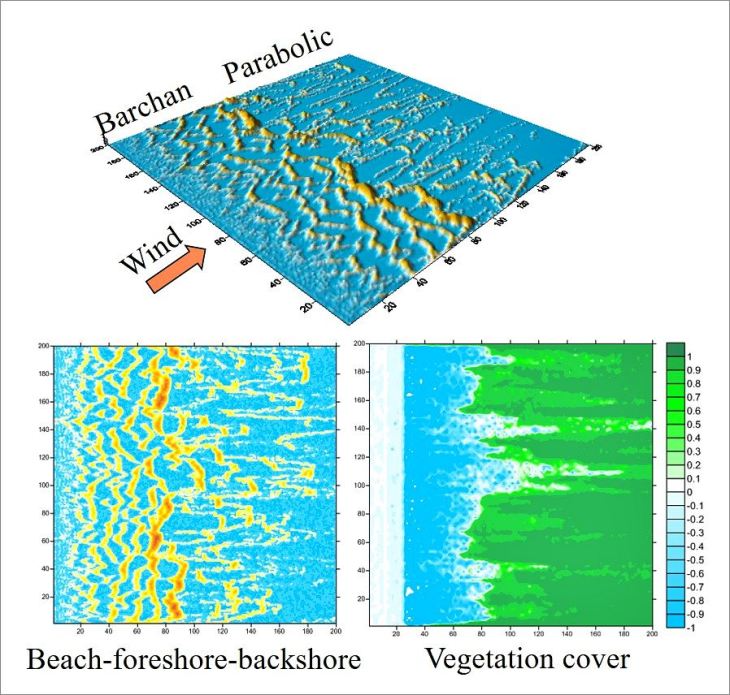
Simulation results in the formation of two common dune types (Graphic: Wenyan Zhang / HZG)
Dr Wenyan Zhang fed the model with data from the Intergovernmental Panel on Climate Change concerning expected sea level rise. In addition, he began from different scenarios – for one experiment, he programmed the model so that there were stronger storms up until the year 2050, while in another, he left the storm events unchanged. In the end, the results show that with sea level rise, the material erosion from the steep Usedom coast increases and that the dunes around Świnoujście will continue to grow. The model also shows, however, that the dunes will change if, in the future, the wind increasingly hits the coast perpendicularly from a northerly direction. In this case, sand would also be increasingly removed on the Polish side, near the seaside resort of Międzyzdroje, and carried to the mouth of the Oder River. Should the winds become stronger with climate change, the dunes themselves will also change. „The dunes become thinner, but higher. They obviously possess a sort of self-healing ability with which they react to changing conditions,” says Zhang. This is only, however, if we assume that storms do not arise too frequently. If many strong storms occur one after another, the dune’s destroyed vegetation layer isn’t provided with enough time to sufficiently recover – the dunes could therefore diminish more quickly.
Ancient and persevering Baltic Sea dunes
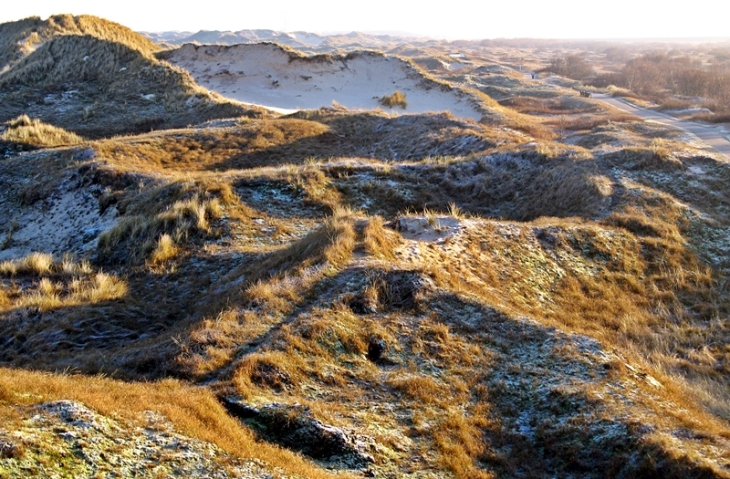
How is the dune landscape changing? (Photo: Ina Frings)
Looking into the future, however, isn’t everything. Experts at the Institute of Coastal Research particularly wish to discover even more about the dunes and their pasts. They strive to understand how the dunes change over the course of thousands of years – through changes in sea level over the course of cold and warm periods or through climate changes, with which the direction and strength of the wind varies. Dr Zhang therefore analysed the dune changes in the southwestern Baltic Sea for the last eight thousand years using his mathematical model.
This, however, is only possible if you have an idea of how the wind behaved during that time. His colleague, Dr Eduardo Zorita, provided him with this vital information. Zorita looks at the climate of the past: the paleoclimate. He wants to understand how heavily climate changes through natural processes, not least to be able to estimate the extent to which humans drive today’s climate change. “We model the climate of the past, for example, by incorporating information on solar activity as well as volcanic eruptions into our model – the latter have considerable influence on global solar radiation, as volcanic eruptions throw material high into the atmosphere,” says Dr Zorita. He had his model calculate how, over the course of the last eight thousand years, the wind conditions and thus the waves have changed globally – and from this information he extracts the wind values for Dr Wenyan Zhang for the Baltic Sea.
Zhang then has these values integrated into his model – together with information about the Baltic Sea water level. The Baltic was a lake eight thousand years ago, separated from the North Sea by a land bridge. This land bridge overflowed from sea level rise at that time and filled the Baltic Sea basin. The sea level has not risen notably for six thousand years, which means the dunes could form. “Our calculations also show that little else has changed since then. The winds during that period blew mainly from the west, with only the primary wind direction slightly shifting a few degrees,” Dr Zhang says, summarising the results. Wave movements and currents, therefore, have hardly changed. Most sand has always come mainly from the west, migrating along the coast and landing in the Oder estuary.
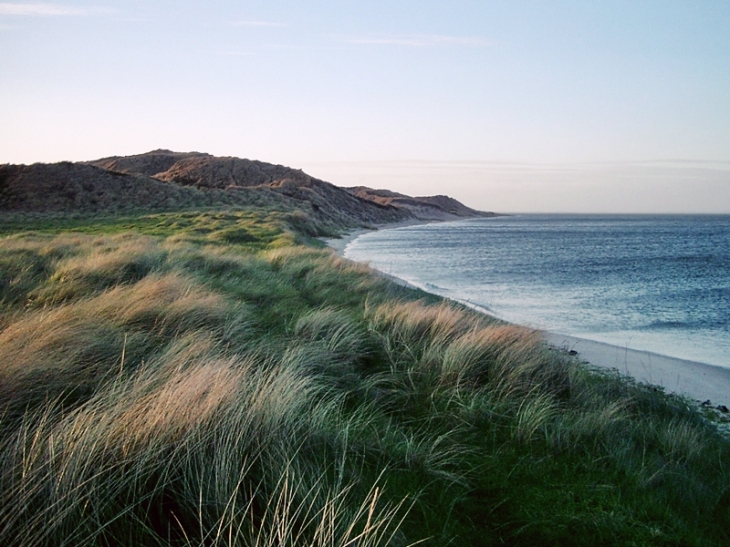
Dune landscape on Sylt (Photo: Dirk Hellriegel)
The reason that Dr Wenyan Zhang, who studied at the Sun Yat-Sen University in the southern Chinese metropolis of Guangzhou, is so closely focussed on the German-Polish Baltic Sea coast is simple: “Most of the coasts in China are so heavily altered by humans that we can barely find natural dune systems that are so old. The Baltic Sea is therefore a special region.” But not only the Baltic. The North Sea dunes are also interesting for him because they are, for example, even more varied than in the southern Baltic. Dr Zhang will therefore shift his working focus soon to the west coast of Schleswig-Holstein.
Dunes as an important quantity for climate models
Meanwhile, Dr Birgit Hünicke, head of the “Coastal Impacts and Paleoclimate Department” at the Institute of Coastal Research, keeps an eye on the Baltic Sea. Together with her team and her colleagues at the University of Hamburg, she has most recently studied a very different facet of dune research – she has, to a certain extent, turned Zhang’s approach on its head. Zhang comes to conclusions on the formation and changes in dunes from historical information on wind and waves. The team led by Dr Birgit Hünicke, together with the other specialists, however, examined to what extent one can judge the wind conditions that prevailed at particular times from the shape of a dune. Hünicke explains: “To be able to program climate models realistically, we need to compare them to real data. Since we have no weather records from early history, we need surrogate data, known as proxies, with the help of which we can deduce the prevailing climate and weather of the period.”
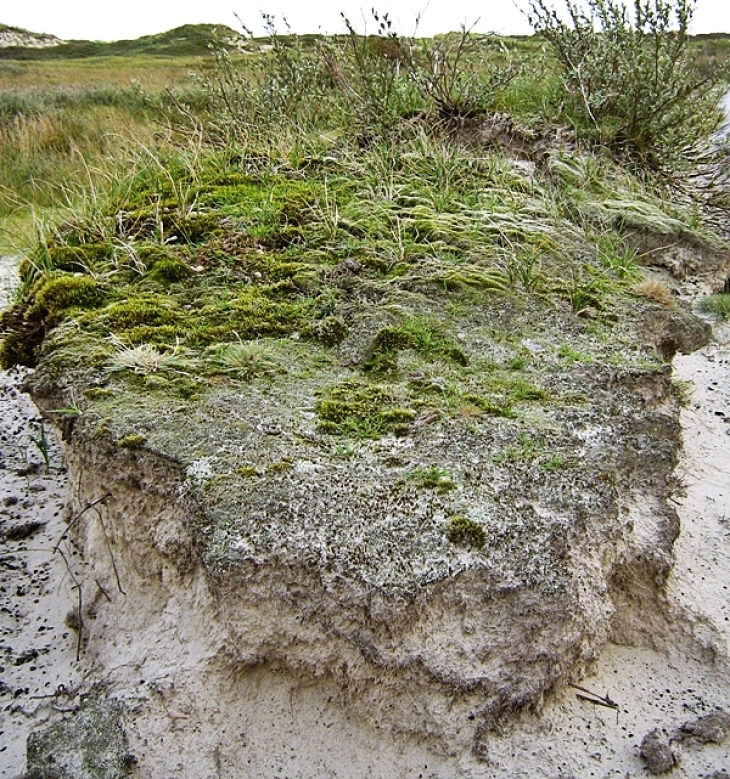
A dune’s noticeable stratification (Photo: Ina Frings)
It was unclear whether the form and stratification of coastal dunes would be useful as a proxy for looking at the climate history of the Baltic Sea. To answer the question, Dr Hünicke and her team analysed specific radar images of dunes on the Polish Baltic Sea taken by Hamburg colleagues. With the help of a ground radar pulled by a small hand truck over the ground, the scientists can see deep into the dunes and observe how they are layered. The layers in turn indicate the wind strength and from which direction the wind was blowing at certain times. The stratification is therefore a sort of fingerprint of climate history.
Dr Hünicke and her team have actually managed to make dunes usable as proxies. They have developed what is known as a statistical model, a type of dune formula that can be incorporated in the future as an additional parameter in climate models.
The question as to why the Ghanaian coast is shrinking
Apart from naturally influencing variables, humans today play a considerable role in altering the dune landscapes and sandy coasts. This makes research into coastal changes complicated. Coasts are shrinking in many locations around the world, coastlines are retreating and material goes missing. To understand the causes, we must be able to differentiate between influences that are natural, such as wind, waves and currents, and what portion of such influences is caused by humans. At the Institute of Coastal Research a study has recently been carried out to investigate why the sandy coasts and dunes in certain areas along the coast of the west African nation of Ghana are shrinking. The results showed that this retreat is not least caused by construction measures and sand removal in other locations – this impact is therefore not directly detectable. The HZG study is now to become the basis for a master plan to protect the Ghanaian coast. Research into dunes is gaining importance worldwide in the face of climate change and sea level rise. The HZG has taken an initial step in this work – a step we can discern.
(Text: Tim Schröder, Science Journalist / English Translation: Anupa Srinivasan)
Contact
Head of Department "Coastal Impacts and Paleoclimate"
Phone: +49 (0)4152 87-1883
E-mail contactDepartment "Matter transport and ecosystem dynamics"
Phone: +49 (0)4152 87-1568
E-mail contact